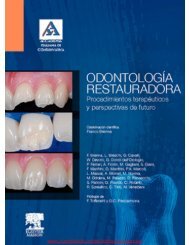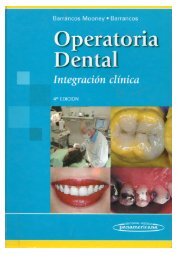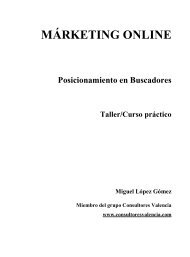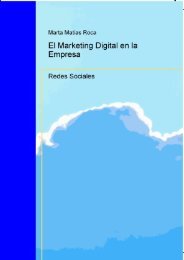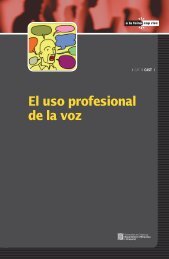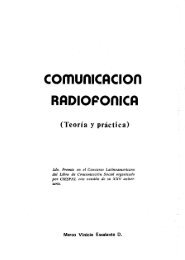- Page 3 and 4:
advertenciaSe ha hecho todo lo posi
- Page 5 and 6:
Profesor Asociado, Departamento de
- Page 7 and 8:
Editada como libro impreso en 2018.
- Page 9 and 10:
graciasEs casi innecesario menciona
- Page 11 and 12:
Títulos de los diagnósticos que h
- Page 13 and 14:
el debate y la mejora de los miembr
- Page 15 and 16:
Los brotes en los diagnósticos enf
- Page 17 and 18:
diarreaalimentos dignidad humanadin
- Page 19 and 20:
motilidad gastrointestinal mutilaci
- Page 21 and 22:
sufrimiento espiritual quesufren la
- Page 23 and 24:
abstractoParte 1 La terminología d
- Page 25 and 26:
7 Introducción a la taxonomía de
- Page 27 and 28:
Estilo de vida La disposición a se
- Page 29 and 30:
riesgo incontinencia urinaria de ur
- Page 31 and 32:
en actividad toleranciaen el riesgo
- Page 33 and 34:
paternidad Riesgo de deterioro de l
- Page 35 and 36:
sobrecarga La negación demiedo y e
- Page 37 and 38:
riesgo aspiraciónriesgo sequedad e
- Page 39 and 40:
hipotermiariesgo hipotermiariesgo L
- Page 41 and 42:
La terminología de la NANDA Intern
- Page 43 and 44:
2 Lo que es nuevo en la edición 20
- Page 45 and 46:
disponible en nuestro sitio. Este p
- Page 47 and 48:
LOE 3.1: Síntesis de la literatura
- Page 49 and 50:
Nuevos diagnósticos de enfermería
- Page 51 and 52:
Diagnóstico de enfermería revisad
- Page 53 and 54:
riesgo deintolerancia a laactividad
- Page 55 and 56:
expresión "padres / pareja".proces
- Page 57 and 58:
emancipado problemas parala toma de
- Page 59 and 60:
3.5 Diagnósticos de enfermería re
- Page 61 and 62:
3.6 Revisión de títulos diagnóst
- Page 63 and 64:
Cuando usted dice falta en Inglés,
- Page 65 and 66:
3.8 Introducción de "en riesgo las
- Page 67 and 68:
profesión de enfermería; por lo q
- Page 69 and 70:
por la NANDA-I en cada país, sin d
- Page 71 and 72:
La NANDA-I cree que la estructura d
- Page 73 and 74:
La NANDA-I existe para desarrollar,
- Page 75 and 76:
La participación de los miembros d
- Page 77 and 78:
Aspectos teóricos de diagnósticos
- Page 79 and 80:
5.1 Introduccióncuidado de la salu
- Page 81 and 82:
Manual diagnóstico y estadístico
- Page 83:
5.2 Como enfermera (o estudiante de
- Page 86 and 87:
5.4 Evaluación del pacienteLa eval
- Page 88 and 89:
diagnóstico 5.5 de enfermeríaUn d
- Page 90 and 91:
usualmente recogida durante la eval
- Page 92 and 93:
5.6 Planificación / intervenciónU
- Page 94 and 95:
5.7 Reevaluación continuaUn diagn
- Page 96 and 97:
las revisiones de diagnóstico y /
- Page 98 and 99:
5:10 ReferenciasAsociación America
- Page 100 and 101:
6.1 IntroducciónEl razonamiento cl
- Page 102 and 103:
Sin una base sólida de los concept
- Page 104 and 105:
6.2 El proceso de enfermeríaLa eva
- Page 106 and 107:
Sin embargo, teniendo en cuenta est
- Page 108 and 109:
presuponer que todos los pacientes
- Page 110 and 111:
Global Subjetiva (ASG) y / o el Min
- Page 112 and 113:
puntos de presión y de posicionami
- Page 114 and 115:
6.3 Análisis de DatosEl segundo pa
- Page 116 and 117:
(Frequency 40) y la superficie marc
- Page 118 and 119:
se emplean las direcciones. Por eje
- Page 120 and 121:
6.4 diagnósticos de enfermería de
- Page 122 and 123:
intestinal, se puede empezar a ver
- Page 124:
esta situación - elementos muy imp
- Page 127 and 128:
si la información obtenida y compa
- Page 129 and 130:
Cambio en loshábitosalimenticiosDo
- Page 131 and 132:
enfermera está considerando las si
- Page 133 and 134:
Siempre es útil pedir a un colega
- Page 135 and 136:
6.6 ResumenLa evaluación juega un
- Page 137 and 138:
7 Introducción a la Taxonomía de
- Page 139 and 140:
aprendido a la taxonomía biológic
- Page 141 and 142:
Con la información recibida, nos e
- Page 143 and 144:
7.2 Clasificación en enfermeríaPr
- Page 146 and 147:
conocimientos de enfermería incluy
- Page 148 and 149:
7.4 Estructuración de programas de
- Page 150 and 151:
7.5 La identificación de un diagn
- Page 152 and 153:
riesgo o relacionado y las caracter
- Page 154 and 155:
tres diagnósticos potenciales: con
- Page 156 and 157:
control sanitarioIdentificación, c
- Page 158 and 159:
00015 riesgo estreñimiento00012 es
- Page 160 and 161:
Clase 2.OrientaciónPercepción del
- Page 162 and 163:
Sin diagnóstico en el momento.Clas
- Page 164 and 165:
Clase 1.ValoresIdentificación y cl
- Page 166 and 167:
riesgos ambientales00181 contaminac
- Page 168 and 169:
7.7 ReferenciasA. Abbott Los sistem
- Page 170 and 171:
8.1 Estructura de la Taxonomía IIU
- Page 172 and 173:
8.2 Un sistema multiaxial para cons
- Page 174 and 175:
8.3 Definiciones ejes8.3.1 Eje 1: E
- Page 176 and 177:
control de los impulsos decontrol e
- Page 178 and 179:
Toma de decisionesLa toma de decisi
- Page 180 and 181:
excesivoCantidad de algo que está
- Page 182 and 183:
olfativoEn relación con el sentido
- Page 184 and 185:
8.4 Preparación y presentación de
- Page 186 and 187:
8.5 Las perspectivas de futuroLa NA
- Page 188 and 189:
8.7 ReferenciasLundberg C, Warren J
- Page 190 and 191:
9.2 Cuando necesitamos diagnóstico
- Page 192 and 193:
Alrededor de 9,3 lenguajes enfermer
- Page 194 and 195:
9.4 Acerca de la NANDA-I¿Cuál es
- Page 196 and 197:
diagnósticos de enfermería,de enf
- Page 198 and 199:
La NANDA-I proporciona una lista de
- Page 200 and 201:
la mejora continua de la atención
- Page 202 and 203:
cirugía de hoy y las posibles comp
- Page 204 and 205:
específicos, tales como la insufic
- Page 206 and 207:
¿Puedo cambiar un diagnóstico de
- Page 208 and 209:
Esa es una pregunta difícil y que,
- Page 210 and 211:
9.8 Acerca de los factores de riesg
- Page 212 and 213:
Puedo añadir "riesgo" para un diag
- Page 214 and 215:
09:10 Sobre el desarrollo de un pla
- Page 216 and 217:
completado antes de ir a otra cosa
- Page 218 and 219:
Elijo un diagnóstico de cada uno d
- Page 220 and 221:
específica - se aprenderán con la
- Page 222 and 223:
Acerca de 9:13 preparación y el ex
- Page 224 and 225:
NANDA Internacional sólo se comenz
- Page 226 and 227:
10 Glosario10.1 diagnóstico de enf
- Page 228 and 229:
10.2 Eje diagnóstico10.2.1 EjeUn e
- Page 230 and 231:
Eje 3: EnsayoUn ensayo es un descri
- Page 232 and 233:
10.3 Componentes de un diagnóstico
- Page 234 and 235:
10.4 Definiciones para la clasifica
- Page 236 and 237:
diagnósticos de enfermería de la
- Page 238 and 239:
La participación en actividades re
- Page 240 and 241:
Área 1 • Promoción de la saludc
- Page 242 and 243:
Área 1 • Promoción de la saludc
- Page 244 and 245:
Área 1 • Promoción de la saludc
- Page 246 and 247:
Área 1 • Promoción de la saludc
- Page 248 and 249:
bibliografía de apoyo original dis
- Page 250 and 251:
voluntad de control sanitario mejor
- Page 252 and 253:
control sanitario familia ineficace
- Page 254 and 255:
mantenimiento ineficaz saludAprobad
- Page 256 and 257:
Área 1 • Promoción de la saludc
- Page 258 and 259:
las condiciones asociadasagente far
- Page 260 and 261:
salud comunidad pobreAprobado en 20
- Page 262 and 263:
Síndrome de ancianos frágilesApro
- Page 264 and 265:
pérdida no intencional de 25% del
- Page 266 and 267:
riesgo el síndrome de ancianos fr
- Page 268 and 269:
Dominio 2 • Nutriciónclase 1 •
- Page 270 and 271:
condición asociadaembarazobibliogr
- Page 272 and 273:
Amamantamiento ineficazAprobado en
- Page 274 and 275:
Dominio 2 • Nutriciónclase 1 •
- Page 276 and 277:
Dominio 2 • Nutriciónclase 1 •
- Page 278 and 279:
Dominio 2 • Nutriciónclase 1 •
- Page 280 and 281:
La asfixia arcadasdeglución repeti
- Page 282 and 283:
Este diagnóstico será retirado de
- Page 284 and 285:
la dinámica de los alimentos adole
- Page 286 and 287:
Dominio 2 • Nutriciónclase 1 •
- Page 288 and 289:
hora de las comidas estresantes nor
- Page 290 and 291:
Dominio 2 • Nutriciónclase 1 •
- Page 292 and 293:
desventaja económicaLa implicació
- Page 294 and 295:
estándar ineficaz de alimentación
- Page 296 and 297:
nutrición des equilibrada: menos q
- Page 298 and 299:
Dominio 2 • Nutriciónclase 1 •
- Page 300 and 301:
Dominio 2 • Nutriciónclase 1 •
- Page 302 and 303:
rápido aumento de peso durante la
- Page 304 and 305:
sobrepesoAprobado en 2013 • Revis
- Page 306 and 307:
Dominio 2 • Nutriciónclase 1 •
- Page 308 and 309:
rápido aumento de peso durante la
- Page 310 and 311:
Dominio 2 • Nutriciónclase 3 •
- Page 312 and 313:
riesgo la función hepática dañad
- Page 314 and 315:
riesgo glucosa en la sangre inestab
- Page 316 and 317:
hiperbilirrubinemia neonatalAprobad
- Page 318 and 319:
Dominio 2 • Nutriciónclase 4 •
- Page 320 and 321:
La infección viralNiño con defici
- Page 322 and 323:
riesgo síndrome de desequilibrio m
- Page 324 and 325:
des riesgo el equilibrio de electro
- Page 326 and 327:
el volumen de líquido deficienteAp
- Page 328 and 329:
Dominio 2 • Nutriciónclase 5 •
- Page 330 and 331:
Dominio 2 • Nutriciónclase 5 •
- Page 332 and 333:
Presencia accidental respiratoria u
- Page 334 and 335:
riesgo volumen de líquido des equi
- Page 336 and 337:
eliminación urinaria alteradaAprob
- Page 338 and 339:
incontinencia urinaria de esfuerzoA
- Page 340 and 341:
incontinencia urinaria de urgenciaA
- Page 342 and 343:
riesgo incontinencia urinaria de ur
- Page 344 and 345:
incontinencia urinaria funcionalApr
- Page 346 and 347:
incontinencia urinaria desbordamien
- Page 348 and 349:
incontinencia reflejo de micciónAp
- Page 350 and 351:
retención urinarioAprobado en 1986
- Page 352 and 353:
estreñimientoAprobado en 1975 •
- Page 354 and 355:
anorrectal estenosis defisuras Hemo
- Page 356 and 357:
riesgo estreñimientoAprobado en 19
- Page 358 and 359:
• Eliminación de dominio 3 y el
- Page 360 and 361:
• Eliminación de dominio 3 y el
- Page 362 and 363:
taburete retención postura Presenc
- Page 364 and 365:
• Eliminación de dominio 3 y el
- Page 366 and 367:
la diabetes mellitusLa distrofia mi
- Page 368 and 369:
diarreaAprobado en 1975 • Revisad
- Page 370 and 371:
• Eliminación de dominio 3 y el
- Page 372 and 373:
aumento anormal de la capacidad de
- Page 374 and 375:
motilidad gastrointestinal disfunci
- Page 376 and 377:
• Eliminación de dominio 3 y el
- Page 378 and 379:
bibliografía de apoyo original dis
- Page 380 and 381:
• Eliminación de dominio 3 y el
- Page 382 and 383:
Desequilibrio en la ventilación-pe
- Page 384 and 385:
insomnioAprobado en 2006 • Revisa
- Page 386 and 387:
Dominio 4 • Actividad / sueñocla
- Page 388 and 389:
Dominio 4 • Actividad / sueñocla
- Page 390 and 391:
Prolongado asincronía circadiano b
- Page 392 and 393:
voluntad de sueño mejoradoAprobado
- Page 394 and 395:
capacidad de transferencia dañadoA
- Page 396 and 397:
Dominio 4 • Actividad / sueñocla
- Page 398 and 399:
bibliografía de apoyo original dis
- Page 400 and 401:
El levantarse heridoAprobado en 201
- Page 402 and 403:
Dominio 4 • Actividad / sueñocla
- Page 404 and 405:
lesión neuromuscularproblemas de v
- Page 406 and 407:
movilidad discapacitados físicosAp
- Page 408 and 409:
Dominio 4 • Actividad / sueñocla
- Page 410 and 411:
Dominio 4 • Actividad / sueñocla
- Page 412 and 413:
trastorno psicológicobibliografía
- Page 414 and 415:
riesgo síndrome de desusoAprobado
- Page 416 and 417:
campo de energía des equilibradoAp
- Page 418 and 419:
Dominio 4 • Actividad / sueñocla
- Page 420 and 421:
no estimular los factores de estré
- Page 422 and 423:
perambulationAprobado en 2000 • R
- Page 424 and 425:
Dominio 4 • Actividad / sueñocla
- Page 426 and 427:
Disminución de los pulsos perifér
- Page 428 and 429:
Dominio 4 • Actividad / sueñocla
- Page 430 and 431:
Dominio 4 • Actividad / sueñocla
- Page 432 and 433:
La posición del cuerpo que inhibe
- Page 434 and 435:
riesgo perfusión tisular disminuci
- Page 436 and 437:
riesgo perfusión tisular cerebro i
- Page 438 and 439:
Dominio 4 • Actividad / sueñocla
- Page 440 and 441:
de fumarlas condiciones asociadasLa
- Page 442 and 443:
riesgo perfusión tisular periféri
- Page 444 and 445:
riesgo presión arterial inestableA
- Page 446 and 447:
Dominio 4 • Actividad / sueñocla
- Page 448 and 449:
GravesagitaciónEl aumento de la fr
- Page 450 and 451:
Dominio 4 • Actividad / sueñocla
- Page 452 and 453:
Dominio 4 • Actividad / sueñocla
- Page 454 and 455:
Dominio 4 • Actividad / sueñocla
- Page 456 and 457:
Dominio 4 • Actividad / sueñocla
- Page 458 and 459:
Cambio en la pérdida de la funció
- Page 460 and 461:
déficit autocuidado, bañoAprobado
- Page 462 and 463:
déficit autocuidado para la higien
- Page 464 and 465:
déficit vestidor autocuidadoAproba
- Page 466 and 467:
Dominio 4 • Actividad / sueñocla
- Page 468 and 469:
Dominio 4 • Actividad / sueñocla
- Page 470 and 471:
bibliografía de apoyo original dis
- Page 472 and 473:
mantenimiento del hogar dañadoApro
- Page 474 and 475:
El dominio 5 • La percepción / c
- Page 476 and 477:
Transferencia de la sensación de d
- Page 478 and 479:
El dominio 5 • La percepción / c
- Page 480 and 481:
confusión agudoAprobado en 1994
- Page 482 and 483:
El dominio 5 • La percepción / c
- Page 484 and 485:
bibliografía de apoyo original dis
- Page 486 and 487:
confusión crónicaAprobado en 1994
- Page 488 and 489:
conocimiento deficienteAprobado en
- Page 490 and 491:
voluntad de conocimiento mejoradoAp
- Page 492 and 493:
control de los impulsos ineficazApr
- Page 494 and 495:
El dominio 5 • La percepción / c
- Page 496 and 497:
trastorno emocionallas condiciones
- Page 498 and 499:
memoria dañadoAprobado en 1994 •
- Page 500 and 501:
Domínio 5 • Percepção/cogniç
- Page 502 and 503:
Domínio 5 • Percepção/cogniç
- Page 504 and 505:
Verbalização inapropriadaFatores
- Page 506 and 507:
Disposição para autoconceito melh
- Page 508 and 509:
Risco de dignidade humana compromet
- Page 510 and 511:
Des esperançaAprovado em 1986 •
- Page 512 and 513:
Domínio 6 • AutopercepçãoClass
- Page 514 and 515:
Domínio 6 • AutopercepçãoClass
- Page 516 and 517:
Preconceito percebidoProcessos fami
- Page 518 and 519:
Risco de distúrbio na identidade p
- Page 520 and 521:
Baixa autoestima crônicaAprovado e
- Page 522 and 523:
Domínio 6 • AutopercepçãoClass
- Page 524 and 525:
Domínio 6 • AutopercepçãoClass
- Page 526 and 527:
Transição de desenvolvimentoCondi
- Page 528 and 529:
Risco de baixa autoestima situacion
- Page 530 and 531:
Distúrbio na imagem corporalAprova
- Page 532 and 533:
Domínio 7 • Papéis e relacionam
- Page 534 and 535:
HostilidadeInadequação ao papel p
- Page 536 and 537:
Disposição cognitiva insuficiente
- Page 538 and 539:
Risco de paternidade ou maternidade
- Page 540 and 541:
Grande número de gestaçõesGravid
- Page 542 and 543:
Disposição para paternidade ou ma
- Page 544 and 545:
Tensão do papel de cuidadorAprovad
- Page 546 and 547:
No cuidadorAbuso de substânciasAut
- Page 548 and 549:
No receptor de cuidadosAlteração
- Page 550 and 551:
Risco de tensão do papel de cuidad
- Page 552 and 553:
AlienaçãoApoio social insuficient
- Page 554 and 555:
Processos familiares disfuncionaisA
- Page 556 and 557:
AbandonoAnsiedadeAssumir responsabi
- Page 558 and 559:
Populações em riscoDesfavorecido
- Page 560 and 561:
Processos familiares interrompidosA
- Page 562 and 563:
Domínio 7 • Papéis e relacionam
- Page 564 and 565:
Domínio 7 • Papéis e relacionam
- Page 566 and 567:
Domínio 7 • Papéis e relacionam
- Page 568 and 569:
Domínio 7 • Papéis e relacionam
- Page 570 and 571:
Mudança na percepção de outros s
- Page 572 and 573:
Domínio 7 • Papéis e relacionam
- Page 574 and 575:
Domínio 7 • Papéis e relacionam
- Page 576 and 577:
História de violência domésticaC
- Page 578 and 579:
Risco de relacionamento ineficazApr
- Page 580 and 581:
Disposição para relacionamento me
- Page 582 and 583:
Domínio 8 • SexualidadeClasse 2
- Page 584 and 585:
Condições associadasAlteração n
- Page 586 and 587:
Padrão de sexualidade ineficazApro
- Page 588 and 589:
Risco de binômio mãe-feto perturb
- Page 590 and 591:
Processo perinatológico ineficazAp
- Page 592 and 593:
Domínio 8 • SexualidadeClasse 3
- Page 594 and 595:
Domínio 8 • SexualidadeClasse 3
- Page 596 and 597:
Domínio 9 • Enfrentamento/toler
- Page 598 and 599:
Aconselhamento insuficiente anterio
- Page 600 and 601:
Risco de síndrome do estresse por
- Page 602 and 603:
Síndrome do trauma de estuproAprov
- Page 604 and 605:
Domínio 9 • Enfrentamento/toler
- Page 606 and 607:
NegaçãoPalpitações cardíacasPe
- Page 608 and 609:
Domínio 9 • Enfrentamento/toler
- Page 610 and 611:
Lesão grave a entes queridosOcupa
- Page 612 and 613:
Risco de transição complicada na
- Page 614 and 615:
AnsiedadeAprovado em 1973 • Revis
- Page 616 and 617:
ParassimpáticasAlteração no padr
- Page 618 and 619:
Domínio 9 • Enfrentamento/toler
- Page 620 and 621:
Não aceitação da própria mortal
- Page 622 and 623:
Enfrentamento defensivoAprovado em
- Page 624 and 625:
Domínio 9 • Enfrentamento/toler
- Page 626 and 627:
Apoio social insuficiente Avaliaç
- Page 628 and 629:
Disposição para enfrentamento mel
- Page 630 and 631:
Enfrentamento familiar comprometido
- Page 632 and 633:
Domínio 9 • Enfrentamento/toler
- Page 634 and 635:
Fatores relacionadosEstilos de enfr
- Page 636 and 637:
Disposição para enfrentamento fam
- Page 638 and 639:
Enfrentamento ineficaz da comunidad
- Page 640 and 641:
Disposição para enfrentamento mel
- Page 642 and 643:
Sobrecarga de estresseAprovado em 2
- Page 644 and 645:
MedoAprovado em 1980 • Revisado e
- Page 646 and 647:
Domínio 9 • Enfrentamento/toler
- Page 648 and 649:
Medo da separação Medo de perda d
- Page 650 and 651:
PesarAprovado em 1980 • Revisado
- Page 652 and 653:
Domínio 9 • Enfrentamento/toler
- Page 654 and 655:
Sofrimento pela separação Sofrime
- Page 656 and 657:
Risco de pesar complicadoAprovado e
- Page 658 and 659:
Planejamento de atividade ineficazA
- Page 660 and 661:
Risco de planejamento de atividade
- Page 662 and 663:
Regulação do humor prejudicadaApr
- Page 664 and 665:
Domínio 9 • Enfrentamento/toler
- Page 666 and 667:
Recursos inadequadosRecursos insufi
- Page 668 and 669:
Risco de resiliência prejudicadaAp
- Page 670 and 671:
Domínio 9 • Enfrentamento/toler
- Page 672 and 673:
Domínio 9 • Enfrentamento/toler
- Page 674 and 675:
Desfavorecido economicamenteCondiç
- Page 676 and 677:
Risco de sentimento de impotênciaA
- Page 678 and 679:
Domínio 9 • Enfrentamento/toler
- Page 680 and 681:
Domínio 9 • Enfrentamento/toler
- Page 682 and 683:
Domínio 9 • Enfrentamento/toler
- Page 684 and 685:
Domínio 9 • Enfrentamento/toler
- Page 686 and 687:
TaquicardiaProblemas regulatóriosI
- Page 688 and 689:
Domínio 9 • Enfrentamento/toler
- Page 690 and 691:
Prejuízo oral do lactenteProcedime
- Page 692 and 693:
Disposição para comportamento org
- Page 694 and 695:
Disreflexia autonômicaAprovado em
- Page 696 and 697:
Populações em riscoEjaculaçãoEx
- Page 698 and 699:
Risco de disreflexia autonômicaApr
- Page 700 and 701:
Embolia pulmonarEpididimite Fratura
- Page 702 and 703:
Síndrome de abstinência de subst
- Page 704 and 705:
Risco de síndrome de abstinência
- Page 706 and 707:
Síndrome de abstinência neonatalA
- Page 708 and 709:
Domínio 10 • Princípios da vida
- Page 710 and 711:
Disposição para bem-estar espirit
- Page 712 and 713:
Domínio 10 • Princípios da vida
- Page 714 and 715:
Crise espiritualCrise pessoalCrises
- Page 716 and 717:
Risco de religiosidade prejudicadaA
- Page 718 and 719:
Domínio 10 • Princípios da vida
- Page 720 and 721:
Domínio 10 • Princípios da vida
- Page 722 and 723:
Separação do sistema de apoioCone
- Page 724 and 725:
Domínio 10 • Princípios da vida
- Page 726 and 727:
Conflito racialEnvelhecimentoEvento
- Page 728 and 729:
Sofrimento moralAprovado em 2006
- Page 730 and 731:
Conflito de decisãoAprovado em 198
- Page 732 and 733:
Domínio 10 • Princípios da vida
- Page 734 and 735:
Domínio 10 • Princípios da vida
- Page 736 and 737:
Sistemas de saúde tradicionais hie
- Page 738 and 739:
Risco de tomada de decisão emancip
- Page 740 and 741:
Disposição para tomada de decisã
- Page 742 and 743:
Risco de infecçãoAprovado em 1986
- Page 744 and 745:
Domínio 11 • Segurança/proteç
- Page 746 and 747:
Tipo de procedimento cirúrgico Uso
- Page 748 and 749:
Risco de aspiraçãoAprovado em 198
- Page 750 and 751:
Domínio 11 • Segurança/proteç
- Page 752 and 753:
Domínio 11 • Segurança/proteç
- Page 754 and 755:
Domínio 11 • Segurança/proteç
- Page 756 and 757:
Hábitos alimentares inadequados Hi
- Page 758 and 759:
Desobstrução ineficaz das vias a
- Page 760 and 761:
Domínio 11 • Segurança/proteç
- Page 762 and 763:
Domínio 11 • Segurança/proteç
- Page 764 and 765:
Manchas brancas na boca Manchasespo
- Page 766 and 767:
Domínio 11 • Segurança/proteç
- Page 768 and 769:
Doença autoimuneEstado de jejum or
- Page 770 and 771:
Integridade da pele prejudicadaApro
- Page 772 and 773:
Domínio 11 • Segurança/proteç
- Page 774 and 775:
Alteração no metabolismoAlteraç
- Page 776 and 777:
Integridade tissular prejudicadaApr
- Page 778 and 779:
Domínio 11 • Segurança/proteç
- Page 780 and 781:
Trauma vascularLiteratura de apoio
- Page 782 and 783:
Risco de lesãoAprovado em 1978 •
- Page 784 and 785:
Domínio 11 • Segurança/proteç
- Page 786 and 787:
Domínio 11 • Segurança/proteç
- Page 788 and 789:
Domínio 11 • Segurança/proteç
- Page 790 and 791:
Domínio 11 • Segurança/proteç
- Page 792 and 793:
Escore de classificação do estado
- Page 794 and 795:
Risco de lesão térmicaAprovado em
- Page 796 and 797:
Risco de morte súbita do lactenteA
- Page 798 and 799:
Domínio 11 • Segurança/proteç
- Page 800 and 801:
Mobilidade prejudicadaRedução da
- Page 802 and 803:
Domínio 11 • Segurança/proteç
- Page 804 and 805:
Escore de classificação do estado
- Page 806 and 807:
Risco de recuperação cirúrgica r
- Page 808 and 809:
Domínio 11 • Segurança/proteç
- Page 810 and 811:
Ventilação mecânicaLiteratura de
- Page 812 and 813:
Risco de sangramentoAprovado em 200
- Page 814 and 815:
Risco de sufocaçãoAprovado em 198
- Page 816 and 817:
Domínio 11 • Segurança/proteç
- Page 818 and 819:
Domínio 11 • Segurança/proteç
- Page 820 and 821:
Fiação elétrica sem fixação Fu
- Page 822 and 823:
Domínio 11 • Segurança/proteç
- Page 824 and 825:
TrombofiliaUso de contraceptivos co
- Page 826 and 827:
AutomutilaçãoAprovado em 2000 •
- Page 828 and 829:
Condições associadasAutismoDesper
- Page 830 and 831:
Risco de automutilaçãoAprovado em
- Page 832 and 833:
Domínio 11 • Segurança/proteç
- Page 834 and 835:
Domínio 11 • Segurança/proteç
- Page 836 and 837:
DesesperançaDificuldades legaisIso
- Page 838 and 839:
Domínio 11 • Segurança/proteç
- Page 840 and 841:
Este diagnóstico será retirado da
- Page 842 and 843:
Risco de violência direcionada a s
- Page 844 and 845:
Domínio 11 • Segurança/proteç
- Page 846 and 847:
Efeitos neurológicos da exposiçã
- Page 848 and 849:
Domínio 11 • Segurança/proteç
- Page 850 and 851:
TabagismoPopulações em riscoCrian
- Page 852 and 853:
Risco de envenenamentoAprovado em 1
- Page 854 and 855:
Risco de lesão ocupacionalAprovado
- Page 856 and 857:
Domínio 11 • Segurança/proteç
- Page 858 and 859:
Domínio 11 • Segurança/proteç
- Page 860 and 861:
Domínio 11 • Segurança/proteç
- Page 862 and 863:
Características gastrintestinaisDo
- Page 864 and 865:
Risco de reação alérgica ao lát
- Page 866 and 867:
HipertermiaAprovado em 1986 • Rev
- Page 868 and 869:
Domínio 11 • Segurança/proteç
- Page 870 and 871:
PalidezSofrimento respiratórioFato
- Page 872 and 873:
Domínio 11 • Segurança/proteç
- Page 874 and 875:
Suprimento insuficiente de gordura
- Page 876 and 877:
Risco de hipotermia perioperatória
- Page 878 and 879:
Termorregulação ineficazAprovado
- Page 880 and 881:
Domínio 11 • Segurança/proteç
- Page 882 and 883:
Trauma
- Page 884 and 885:
Conforto prejudicadoAprovado em 200
- Page 886 and 887:
Domínio 12 • ConfortoClasse 1
- Page 888 and 889:
Domínio 12 • ConfortoClasse 1
- Page 890 and 891:
Agente físico lesivo Agentequímic
- Page 892 and 893:
Dor crônicaAprovado em 1986 • Re
- Page 894 and 895: Domínio 12 • ConfortoClasse 1
- Page 896 and 897: Domínio 12 • ConfortoClasse 1
- Page 898 and 899: Fatores relacionadosA serem desenvo
- Page 900 and 901: NáuseaAprovado em 1998 • Revisad
- Page 902 and 903: Domínio 12 • ConfortoClasse 2
- Page 904 and 905: Recursos insuficientesCondições a
- Page 906 and 907: Disposição para conforto melhorad
- Page 908 and 909: Conforto prejudicadoAprovado em 200
- Page 910 and 911: Domínio 12 • ConfortoClasse 3
- Page 912 and 913: Domínio 12 • ConfortoClasse 3
- Page 914 and 915: Comportamento social incoerente com
- Page 916 and 917: Risco de solidãoAprovado em 1994
- Page 918 and 919: Domínio 13 • Crescimento/desenvo
- Page 920 and 921: Condições associadasDeficiência
- Page 922 and 923: Blair SN, Kohl HW, III, Paffenbarge
- Page 924 and 925: Weiss BD, Palmer R. Relationship be
- Page 926 and 927: Pinto BM, Maruyama NC, Clark MM, Cr
- Page 928 and 929: Newman S, Steed L, Mulligan K. Self
- Page 930 and 931: Nguyen HQ, Carrieri-Kohlman V, Rank
- Page 932 and 933: 294Curtin RB, Sitter DCB, Schatell
- Page 934 and 935: Koch T, Jenkin P, Kralik D. Chronic
- Page 936 and 937: Watts T, Merrell J, Murphy F, Willi
- Page 938 and 939: 461Bartali B, Frongillo EA, Bandine
- Page 940 and 941: 26(2):275-286Afilalo J, Karunananth
- Page 942 and 943: employee health risks. J Occup Envi
- Page 946 and 947: Child Health J. 2015; 19(1):6-16Hun
- Page 948 and 949: infants in neonatal units: a system
- Page 950 and 951: abuse on body image in eating disor
- Page 952 and 953: Kyung ER. Parenting styles and over
- Page 954 and 955: have we been barking up the wrong t
- Page 956 and 957: behaviors, physical activity and se
- Page 958 and 959: US Government Printing Ofice; 2005U
- Page 960 and 961: obesity: practical implications. In
- Page 962 and 963: television viewing and obesity in P
- Page 964 and 965: Barsh GS, Farooqi IS, O’Rahilly S
- Page 966 and 967: sobrepeso em crianças em idade esc
- Page 968 and 969: Stettler N, Kumanyika SK, Katz SH,
- Page 970 and 971: Bierschbach JL, Cooper L, Liedl JA.
- Page 972 and 973: Cheung BM, Li C. Diabetes and hyper
- Page 974 and 975: Weglicki W, Quamme G, Tucker K, Hai
- Page 976 and 977: Teruya J, Styler M, Verde S, Topols
- Page 978 and 979: http://consensus.nih.gov/cons/071/0
- Page 980 and 981: 3.2.1 ConstipaçãoNenhuma referên
- Page 982 and 983: Jamshed N, Lee ZE, Olden KW. Diagno
- Page 984 and 985: Trinh C, Prabhakar K. Diarrheal dis
- Page 986 and 987: 4 Domínio 4: Atividade/repouso4.1
- Page 988 and 989: 4.2 Classe 2: Atividade/exercício4
- Page 990 and 991: Boztosun B, Günes Y, Yildiz A, et
- Page 992 and 993: conceptual review and the applicati
- Page 994 and 995:
Barros ALBL, Gomes IM. Nursing diag
- Page 996 and 997:
syndrome after isolated mitral valv
- Page 998 and 999:
Crit Care Resusc. 2000; 2(1):55-654
- Page 1000 and 1001:
North Am. 1987; 22(1): 12-34Loyola
- Page 1002 and 1003:
adjunct to hypothermic circulatory
- Page 1004 and 1005:
60(9):969-982Khan NA, Rahim SA, Ana
- Page 1006 and 1007:
12). In: Black H. R, Elliot W. J, e
- Page 1008 and 1009:
4.5.5 Disposição para melhora do
- Page 1010 and 1011:
Dyer CB, Pavlik VN, Murphy KP, Hyma
- Page 1012 and 1013:
Pavlik VN, Hyman DJ, Festa NA, Bito
- Page 1014 and 1015:
5.4.1 Confusão agudaAgostini JV, L
- Page 1016 and 1017:
delirium in patients with advanced
- Page 1018 and 1019:
Schor JD, Levkoff SE, Lipsitz LA, e
- Page 1020 and 1021:
medications with anticholinergic ef
- Page 1022 and 1023:
Praticò C, Quattrone D, Lucanto T,
- Page 1024 and 1025:
Disord. 2012; 33(2-3): 189-203Ratfo
- Page 1026 and 1027:
substance abusers with gambling pro
- Page 1028 and 1029:
Palmieri A, Abrahams S, Sorarù G,
- Page 1030 and 1031:
de Jesus IS, Sena ELS, Meira EC, Go
- Page 1032 and 1033:
adults. Clin Nurs Res. 2005; 14(3):
- Page 1034 and 1035:
Gary FA, Baker M, Grandbois DM. Per
- Page 1036 and 1037:
inpatient alcoholics. Issues Ment H
- Page 1038 and 1039:
Nenhuma referência no momento.6.3
- Page 1040 and 1041:
Marital Relation-ship]. Tokyo: Baif
- Page 1042 and 1043:
Muramoto J, Mori A, Eds. Bosei Kang
- Page 1044 and 1045:
Higgins L.P, Hawkins J.W. Screening
- Page 1046 and 1047:
Taketani Y, Kabeyama S, eds. Josang
- Page 1048 and 1049:
9.1 Classe 1: Respostas pós-trauma
- Page 1050 and 1051:
Available from http://www.tdx.cat/b
- Page 1052 and 1053:
death anxiety. J Rehabil. 2000; 66(
- Page 1054 and 1055:
Cysouw-Guitouni A. L’avenir et la
- Page 1056 and 1057:
9.2.9 Enfrentamento ineficaz da com
- Page 1058 and 1059:
Keil RMK. Coping and stress: a conc
- Page 1060 and 1061:
2005; 28(2):290-295So HM, Chan DSK.
- Page 1062 and 1063:
Monat A, Lazarus RS. Stress and Cop
- Page 1064 and 1065:
Genevro JL, Marshall T, Miller T, C
- Page 1066 and 1067:
Plenum; 2003Hogan N, Worden JW, Sch
- Page 1068 and 1069:
Riberio KL. The labyrinth of commun
- Page 1070 and 1071:
Health. 2007; 11(5):532- 537Dimeo F
- Page 1072 and 1073:
2013; 48(1): 17-25van Kessel G. The
- Page 1074 and 1075:
Molina Y, Yi JC, Martinez-Gutierrez
- Page 1076 and 1077:
Colyer H. Women’s experience of l
- Page 1078 and 1079:
55(2):236-240Jeng C, Yang SH, Chang
- Page 1080 and 1081:
Sharp B, Schermer CR, Esposito TJ,
- Page 1082 and 1083:
non-addicted infants. Addiction. 20
- Page 1084 and 1085:
Hover-Kramer D. Creating a context
- Page 1086 and 1087:
Nursing Diagnosis. The Internationa
- Page 1088 and 1089:
Reed PG. An emerging paradigm for t
- Page 1090 and 1091:
Analysis of Spiritual Perspective,
- Page 1092 and 1093:
Chaves E., Carvalho E., Goyatá S.,
- Page 1094 and 1095:
47(4): 491-503Sumner CH. Recognizin
- Page 1096 and 1097:
Mansen TJ. The spiritual dimension
- Page 1098 and 1099:
Pinch WJ, Spielman ML. Parental per
- Page 1100 and 1101:
Ross MM, Carswell A, Hing M, Hollin
- Page 1102 and 1103:
11.1 Classe 1: Infecção11.1.1 Ris
- Page 1104 and 1105:
Tysabri under a special distributio
- Page 1106 and 1107:
JAMA. 2010; 303(24): 2495-2503Medsc
- Page 1108 and 1109:
Am Surg. 2001; 67(3):227-230, discu
- Page 1110 and 1111:
Melling AC, Ali B, Scott EM, Leaper
- Page 1112 and 1113:
Oral Rehabil. 2014; 41 (3):226-235S
- Page 1114 and 1115:
2009; 13(3):49-54Cruz MCFN, Braga V
- Page 1116 and 1117:
bucais relacionadas com o estresse:
- Page 1118 and 1119:
Goiana; 2007Cavalcante AMRZ, Moreir
- Page 1120 and 1121:
Silva PDO, Gorini MIPC. Diagnóstic
- Page 1122 and 1123:
Oliveira AP. de F. Assistência de
- Page 1124 and 1125:
catheters. Nurs Stand. 2009; 23(29)
- Page 1126 and 1127:
Latkany R. Dry eyes: etiology and m
- Page 1128 and 1129:
among elderly hip fracture patients
- Page 1130 and 1131:
de Souza DM, Santos VLCG, Iri HK, S
- Page 1132 and 1133:
matters. AORN J. 2004; 80(2):208-20
- Page 1134 and 1135:
Queiroz FC, Nascimento LC, Leite AM
- Page 1136 and 1137:
diagnoses in patients in the postop
- Page 1138 and 1139:
Butterworth Heinemann; 2007Kocacal
- Page 1140 and 1141:
and illness perspectives. 8th ed. S
- Page 1142 and 1143:
patients. Singapore: Author; 2008Na
- Page 1144 and 1145:
Pastor M, Jiménez I, Moya M, Alman
- Page 1146 and 1147:
pediatric envi- ronmental health: P
- Page 1148 and 1149:
153, quiz 154-155Chalupka SM. Essen
- Page 1150 and 1151:
Argyropoulos CD, Sideris GM, Christ
- Page 1152 and 1153:
protective equipment. Rev Lat Am En
- Page 1154 and 1155:
6). Reston, VA: Author; 2008Bellin
- Page 1156 and 1157:
Widmark JM. Imaging-related medicat
- Page 1158 and 1159:
Association of Perioperative Regist
- Page 1160 and 1161:
newborns. J Perinatol. 2007; 27 Sup
- Page 1162 and 1163:
Waldron S, Mackinnon R. Neonatal th
- Page 1164 and 1165:
Mullany LC, Katz J, Khatry SK, LeCl
- Page 1166 and 1167:
the chilling consequences. AORN J.
- Page 1168 and 1169:
11.6.6 Risco de termorregulação i
- Page 1170 and 1171:
Adv Nurs. 2002; 39(6):599-606Morse
- Page 1172 and 1173:
developing pregnancy-related pelvic
- Page 1174 and 1175:
obesity: results from a prospective
- Page 1176 and 1177:
Waters T, Genaidy A, Barriera Virue
- Page 1178 and 1179:
12.1.6 Dor no trabalho de partoAlme
- Page 1180 and 1181:
Lowe NK. The pain and discomfort of
- Page 1182 and 1183:
Norwalk, CT: Appleton & Lange; 2005
- Page 1184 and 1185:
elderly. Nurs Diagn. 1993; 4(1):37-
- Page 1186 and 1187:
Acesse0800 703 3444 sac@grupoa.com.





